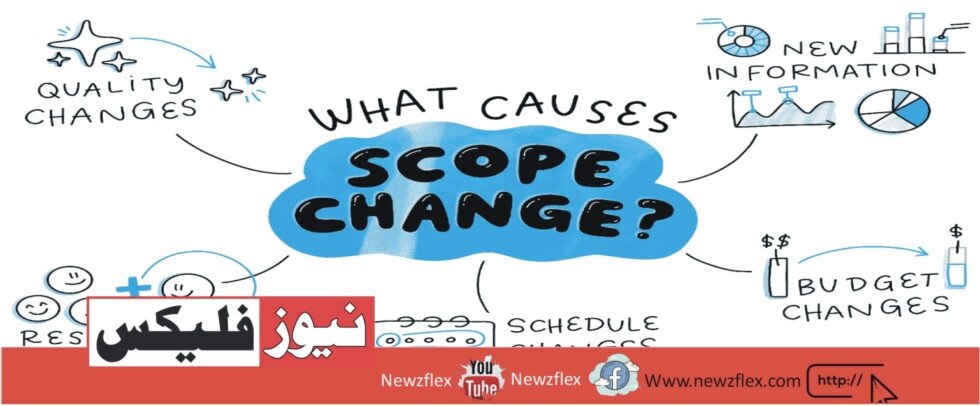
You’re facing scope changes on a project. How can you effectively convey their impact to clients?
Every project faces scope changes. What seemed clear at the start begins to shift—whether due to evolving needs, external factors, or new client expectations. Managing scope changes isn’t just about adjusting timelines and budgets.
It’s about communicating impact effectively. If you don’t, you risk losing trust, wasting resources, and frustrating your team. At NEWZFLEX, we explore ways to manage these challenges without the usual headaches.
Why Most Conversations About Scope Changes Go Wrong
The typical approach is to explain the change in technical terms—new features, extra tasks, more hours. But here’s the truth: Clients don’t care about jargon.
What they want to know is, “How will this affect my goals?” Unfortunately, many project managers fall into the trap of over-explaining the process instead of focusing on outcomes.
A hard truth: If clients don’t see the value behind the change, they won’t support it.
Are You Framing the Conversation Right?
When scope changes happen, it’s easy to slip into defensive mode. You start justifying delays, explaining new requirements, and highlighting risks.
But here’s a question: What if you framed scope changes as opportunities instead of setbacks? The way you present them shapes how clients react.
Steps to Effectively Communicate Scope Changes
1. Link Scope Changes to Client Goals
Clients care about outcomes, not processes. When presenting a scope change, tie it directly to their business goals. Explain how the adjustment will deliver better value or solve emerging challenges.
Example:
“Adding this feature now will make sure the platform stays competitive as your market grows. Without it, we risk falling behind industry trends.”
2. Use Visuals to Simplify Impact
A visual timeline or cost comparison can make a world of difference. Show the client how the scope change affects key milestones or costs. Visual tools cut through confusion and keep everyone on the same page.
Example:
“This graph shows how adding these features will shift the delivery date by two weeks, but it keeps us within the overall project budget.”
3. Be Transparent About Trade-offs
Clients respect honesty. If a scope change will lead to delays, reduced functionality, or additional costs, address it upfront. Avoid sugar-coating. Instead, present alternatives: What’s negotiable? What’s non-negotiable?
Example:
“To deliver the new requirements, we’ll need either more time or an increase in budget. Alternatively, we could delay some features to stay within the original timeline.”
4. Reframe Challenges as Opportunities
Instead of saying, “This will take more time,” say, “This gives us a chance to perfect the product.” Shift the narrative from “problem” to “potential.” Clients respond better when they see a challenge as part of the journey towards something greater.
Example:
“This adjustment allows us to improve functionality that will make a huge difference in your customer’s experience.”
5. Create a Shared Solution
Clients are more likely to support changes if they feel involved in the decision-making. Present scope changes as collaborative solutions rather than directives. Ask for their input on the trade-offs to build trust.
Example:
“Given the new requirements, how would you like us to prioritize features? We can work together to make sure we stay aligned.”
The Danger of Poor Communication
Failing to communicate scope changes properly can cost more than just time and money. It erodes trust, makes clients feel blindsided, and creates unnecessary tension.
Miscommunication around scope changes often leads to resentment—and that’s harder to fix than a delayed deadline.
Are You Thinking Short-Term or Long-Term?
Many project managers focus only on the immediate impact: extra hours, delayed delivery, and added features.
But scope changes are often opportunities to future-proof a project. If you frame them as part of the bigger picture, clients will be more willing to see the value in the change.
The Bottom Line
The next time you face a scope change, remember: It’s not about convincing clients. It’s about helping them see the bigger picture. When clients understand how changes align with their long-term goals, the conversation shifts from resistance to collaboration.
At NEWZFLEX, we believe in tackling difficult conversations with honesty and creativity. Scope changes don’t have to feel like setbacks—they can be stepping stones.
How will you shape your next conversation? Will you fight against the change or use it as a way to strengthen your client relationship?
آپ کو منصوبے میں دائرہ تبدیلیوں کا سامنا ہے۔ آپ مؤثر طریقے سے ان کے اثرات کو کلائنٹس تک کیسے پہنچا سکتے ہیں؟
ہر منصوبے کو دائرہ تبدیلیوں کا سامنا کرنا پڑتا ہے۔ جو بات شروع میں واضح لگتی ہے، وہ وقت کے ساتھ بدلنے لگتی ہے—چاہے یہ ترقی پذیر ضروریات، خارجی عوامل، یا نئے کلائنٹ کی توقعات کی وجہ سے ہو۔ دائرہ تبدیلیوں کا انتظام صرف ٹائم لائنز اور بجٹ کو ایڈجسٹ کرنے کا معاملہ نہیں ہے۔
یہ مؤثر طریقے سے اثرات کو پہنچانے کا معاملہ ہے۔ اگر آپ ایسا نہیں کرتے، تو آپ اعتماد کھو سکتے ہیں، وسائل ضائع کر سکتے ہیں، اور اپنی ٹیم کو مایوس کر سکتے ہیں۔ نیوزفلیکس میں، ہم ان چیلنجوں کا انتظام کرنے کے طریقے تلاش کرتے ہیں بغیر کسی عام سر درد کے۔
دائرہ تبدیلیوں کے بارے میں زیادہ تر بات چیت کیوں غلط ہوتی ہے؟
معمول کا طریقہ یہ ہے کہ تبدیلی کو تکنیکی اصطلاحات میں بیان کیا جائے—نئے فیچرز، اضافی کام، مزید گھنٹے۔ لیکن یہاں سچائی یہ ہے: کلائنٹس کو اصطلاحات کی پرواہ نہیں ہوتی۔
وہ جاننا چاہتے ہیں، “یہ میری مقاصد پر کیسے اثر انداز ہوگا؟” بدقسمتی سے، بہت سے پروجیکٹ منیجر اس بات کا شکار ہو جاتے ہیں کہ وہ عمل کی وضاحت کرنے کے بجائے نتائج پر توجہ دیتے ہیں۔
ایک سخت حقیقت: اگر کلائنٹس تبدیلی کے پیچھے کی قیمت نہیں دیکھتے، تو وہ اس کی حمایت نہیں کریں گے۔
کیا آپ گفتگو کا صحیح فریم بنا رہے ہیں؟
جب دائرہ تبدیلیاں ہوتی ہیں، تو دفاعی موڈ میں آنا آسان ہوتا ہے۔ آپ تاخیر کی وضاحت شروع کرتے ہیں، نئے تقاضے بیان کرتے ہیں، اور خطرات کو اجاگر کرتے ہیں۔
لیکن یہاں ایک سوال ہے: اگر آپ دائرہ تبدیلیوں کو رکاوٹوں کے بجائے مواقع کے طور پر پیش کریں تو کیا ہوگا؟ آپ جس طرح انہیں پیش کرتے ہیں، وہ کلائنٹس کے ردعمل کی شکل کو متاثر کرتا ہے۔
دائرہ تبدیلیوں کو مؤثر طریقے سے پہنچانے کے مراحل
نمبر1 : دائرہ تبدیلیوں کو کلائنٹ کے مقاصد سے جوڑیں
کلائنٹس نتائج کی پرواہ کرتے ہیں، عمل کی نہیں۔ جب آپ دائرہ تبدیلی پیش کرتے ہیں، تو اسے ان کے کاروباری مقاصد سے براہ راست جوڑیں۔ وضاحت کریں کہ یہ ایڈجسٹمنٹ بہتر قیمت فراہم کرے گی یا ابھرتے چیلنجز حل کرے گی۔
مثال: اس فیچر کا اضافہ اب یہ یقینی بنائے گا کہ پلیٹ فارم آپ کے مارکیٹ کے بڑھنے کے ساتھ مسابقتی رہے۔ اس کے بغیر، ہم صنعتی رحجانات کے پیچھے رہنے کا خطرہ مول لیتے ہیں۔
نمبر2 : اثر کو سادہ کرنے کے لیے بصریات کا استعمال کریں
ایک بصری ٹائم لائن یا لاگت کا موازنہ دنیا میں ایک بڑا فرق پیدا کر سکتا ہے۔ کلائنٹ کو دکھائیں کہ دائرہ تبدیلی کیسے اہم سنگ میل یا لاگت کو متاثر کرتی ہے۔ بصری ٹولز کنفیوژن کو کم کرتے ہیں اور سب کو ایک صفحے پر رکھتے ہیں۔
مثال: یہ گراف دکھاتا ہے کہ ان فیچرز کا اضافہ کرنے سے ترسیل کی تاریخ دو ہفتے آگے بڑھ جائے گی، لیکن یہ ہمیں مجموعی پروجیکٹ بجٹ کے اندر رکھتا ہے۔
نمبر3 : تجارت کے بارے میں شفاف رہیں
کلائنٹس ایمانداری کی قدر کرتے ہیں۔ اگر دائرہ تبدیلی کی وجہ سے تاخیر، کم فعالیت، یا اضافی لاگت ہو گی، تو اسے فوراً بیان کریں۔ میٹھے الفاظ میں بات نہ کریں۔ اس کے بجائے، متبادل پیش کریں: کیا بات چیت کی جا سکتی ہے؟ کیا کچھ غیر مذاکراتی ہے؟
مثال: نئے تقاضے پورے کرنے کے لیے، ہمیں یا تو مزید وقت یا بجٹ میں اضافہ کرنا ہوگا۔ بصورت دیگر، ہم کچھ فیچرز کو ملتوی کر سکتے ہیں تاکہ اصل ٹائم لائن کے اندر رہیں۔
نمبر4 : چیلنجز کو مواقع کے طور پر دوبارہ فریم کریں
اس کے بجائے کہ، “یہ مزید وقت لے گا”، کہیے، “یہ ہمیں پروڈکٹ کو بہتر بنانے کا موقع دیتا ہے۔” کہانی کو “مسئلہ” سے “امکان” کی طرف منتقل کریں۔ کلائنٹس اس وقت بہتر جواب دیتے ہیں جب وہ کسی چیلنج کو بہتر چیز کی جانب سفر کا حصہ سمجھتے ہیں۔
مثال: یہ ایڈجسٹمنٹ ہمیں فعالیت کو بہتر بنانے کی اجازت دیتی ہے جو آپ کے صارف کے تجربے میں بڑی تبدیلی کرے گی۔
نمبر5 : مشترکہ حل تیار کریں
اگر کلائنٹس فیصلے میں شامل محسوس کریں تو وہ تبدیلیوں کی حمایت کرنے کے زیادہ امکان رکھتے ہیں۔ دائرہ تبدیلیوں کو ہدایت کے بجائے مشترکہ حل کے طور پر پیش کریں۔ اعتماد بڑھانے کے لیے تجارت پر ان کی رائے طلب کریں۔
مثال: نئے تقاضوں کے پیش نظر، آپ چاہیں گے کہ ہم فیچرز کی ترجیحات کیسے طے کریں؟ ہم مل کر کام کر سکتے ہیں تاکہ یہ یقینی بنائیں کہ ہم ہم آہنگ رہیں۔
ناقص مواصلت کا خطرہ
دائرہ تبدیلیوں کو مؤثر طریقے سے نہ پہنچانا صرف وقت اور پیسے کا نقصان نہیں کرتا۔ یہ اعتماد کو کمزور کرتا ہے، کلائنٹس کو حیرت میں ڈال دیتا ہے، اور غیر ضروری تناؤ پیدا کرتا ہے۔
دائرہ تبدیلیوں کے بارے میں غلط فہمی اکثر رنجش کی طرف لے جاتی ہے—اور یہ تاخیر سے بڑھ کر مشکل ہوتی ہے۔
کیا آپ قلیل مدتی یا طویل مدتی سوچ رہے ہیں؟
بہت سے پروجیکٹ منیجر صرف فوری اثرات پر توجہ دیتے ہیں: اضافی گھنٹے، تاخیر شدہ ترسیل، اور اضافی فیچرز۔
لیکن دائرہ تبدیلیاں اکثر کسی منصوبے کو مستقبل میں محفوظ بنانے کے مواقع ہوتی ہیں۔ اگر آپ انہیں بڑے منظرنامے کا حصہ سمجھتے ہیں، تو کلائنٹس تبدیلی کی قیمت دیکھنے کے لیے زیادہ تیار ہوں گے۔
باٹم لائن
اگلی بار جب آپ دائرہ تبدیلی کا سامنا کریں، تو یاد رکھیں: یہ کلائنٹس کو قائل کرنے کا معاملہ نہیں ہے۔ یہ انہیں بڑے منظرنامے کو دیکھنے میں مدد کرنے کا معاملہ ہے۔ جب کلائنٹس سمجھتے ہیں کہ تبدیلیاں ان کے طویل مدتی مقاصد کے ساتھ کیسے ہم آہنگ ہیں، تو گفتگو مزاحمت سے تعاون کی طرف منتقل ہو جاتی ہے۔
نیوزفلیکس میں، ہم ایمانداری اور تخلیقی صلاحیت کے ساتھ مشکل گفتگو کرنے پر یقین رکھتے ہیں۔ دائرہ تبدیلیاں رکاوٹوں کی طرح محسوس نہیں ہونی چاہئیں—یہ قدم رکھنے کے پتھر ہو سکتی ہیں۔
آپ اپنی اگلی گفتگو کو کیسے تشکیل دیں گے؟ کیا آپ تبدیلی کے خلاف لڑیں گے یا اسے اپنے کلائنٹ کے تعلقات کو مضبوط بنانے کا طریقہ بنائیں گے؟








